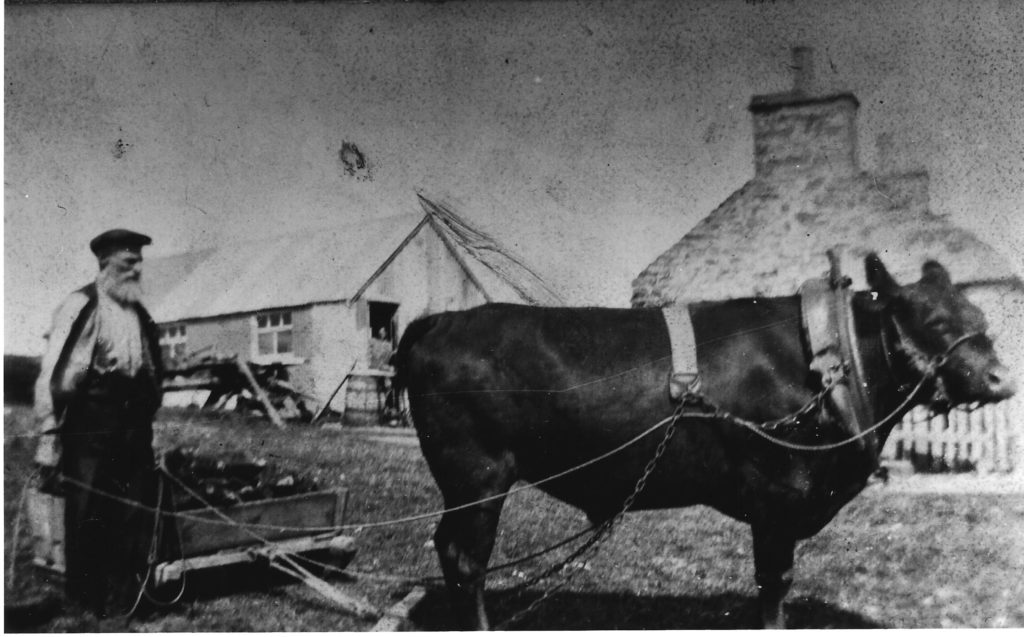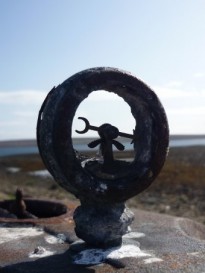Here I’m comparing employment in the 1911 census with the situation in the 1861 census. The usual caveats apply: some people were visiting on census night, others might have been away, it’s a snapshot on a particular night.
First a few general changes to note:
- Population down from 597 to 401.
- Male and female numbers much closer: 198 to 201 in 1911, 267 to 330 in 1861.
- Only 8 (all female) born in Caithness compared to 77 in 1861 (2% of overall population compared to almost 13% in 1861). A linked statistic, almost 92% born in Orkney compared to 83.5% in 1861.
What did people do in 1911?
Looking at the data, four things strike me immediately: a marked drop in the number and percentage of fishermen; the use of a new term, crofter; new sources of income, often supplementing crofting; and lastly employment by the Melsetter estate. I’ll look at them in turn, with women’s work in another blog.
Fishermen
In the 1911 census, just seven men were described as fishermen while a further seven combined fishing with crofting or farming. Even allowing for the decline in population, this is a major change from the 1861 census where there were 59 fishermen, 40 of them with no other recorded occupation, making up almost 30% of all those in work. There were also two farmers who noted fishing as a second occupation in 1861 but no-one with that combination in 1911. Strikingly, all the fishermen apart from two were in the Brims area whereas in 1861 less than half, 23 out of 59, were there. So by 1911 not only had numbers dropped but fishing was concentrated in one area of the parish only.

This change appears to be wider than North Walls and Brims alone for the census report on Orkney as a whole recorded that the number of fishermen was 601, down from 1365 in 1901. That report also noted that the number of fishermen-crofters had risen from 48 to 252. This increase was discussed in the context of falling numbers in agricultural work rather than fishing where it was suggested that, if they had been counted in the agricultural employment category, then the drop would have been less.1Census of Scotland, 1911, Report on the twelfth decennial census of Scotland. Vol. 1 County of Orkney: Occupations. [Parts 24-37] BPP 1912-13 CXIX [Cd.6097] 1663 http://www.histpop.org : accessed 5 May 2020. Reduced numbers of fishermen may have been part of a general decline in inshore fishing around Scotland generally over many years. To be confirmed.
Crofters
In contrast to fishermen, the number of farmers or crofters rose considerably from 26 in 1861 to 66 in 1911, 46 of them with only farming or crofting as an occupation.2(Farm overseers and managers, farm servants and others working on farms not included in these totals.) It is possible that the two shifts are due in part to a change in what people viewed as their main work but the lack of a second occupation for so many does not support that. What other factors were at work?
The 1886 Crofters’ Holdings (Scotland) Act had made a considerable difference to the lives of small farmers, chiefly through security of tenure and fair rents. From 1888 onwards, crofters, i.e. those living on a holding whose rent did not exceed £30 per year, could apply to the new Crofters’ Commission for a rent review. (Read more about this and some of the Walls and Brims applications (pdf)) The terms crofter and farmer theoretically refer to different occupations based on rent and focus – crofting was often supplemented by other sources of income. Without doing further research, I strongly suspect that many, perhaps most, of those who described themselves as farmers were really crofters. My great grandfather, John Ross at Lyness Point, certainly fitted the rent under £30 definition though he was described as a farmer only.

It may be the case that greater security of tenure, coupled with lower rents, reduced the need to fish both for food and for income. With a lower population, it is likely that my great grandfather was not the only one to rent more than one croft at least some of the time. Consequently, crofting or farming was probably more viable than 50 years earlier.
New sources of income
There were new income sources too; two crofters were rural postmen, another a roadworker with the County Council, which ensured they had a reliable, guaranteed income. In other cases, work must have been at least seasonal, possibly all year round, for example those who were gardeners or gardener’s labourer at Melsetter. Crofting was also combined with other occupations- boatmaker, mason (2), shoemaker and shopkeeper- in slight contrast to 1861 where only one farmer did anything apart from fishing, and he was a cooper. Three crofters over 70 were in receipt of an old age pension, first paid from 1 January 1909 and so the first generation to benefit from that.
Estate-related employment
Aspects of this have been mentioned but it is the overall number and the range of employment that is noteworthy in 1911. I have counted those people where the name Melsetter is included in their work description or who were employed at Melsetter farm or whose occupation (gamekeeper for example) could only be on the estate. Farm managers/overseers at large farms, such as Haybrake, were probably tenants rather than in direct employment by the estate and so are not included. My total of 21, compared to 12 or so in 1861, is made up as follows with 1861 figures in brackets.
- Melsetter House (cook, housemaid etc) – 5 (1)
- Ground officer – 1 (2 – land agent and land surveyor)
- Gamekeeper – 2 (1)
- Shepherd – 1 (2)
- Farm manager – 1 (1)
- Farm foreman – 1
- Ploughman – 2+ (1+)
- Cattleman – 1
- Dairymaid – 1 (2)
- Gardener & gardener’s labourer – 3 (2)
- General labourer – 2 3Estate employment: comparisons are complicated by a few factors. In 1861, there was a resident land agent but his nephew, a land surveyor, may have only been there temporarily. By 1911, it is likely that the solicitor in Kirkwall did more of the former’s work. The laird’s family was not in residence in 1861 and so house servants could be fewer; there are a few domestic servants in the neighbourhood though the term was sometimes applied to sisters and daughters living at home. The same is true for ploughmen. In fact, the 1911 census specifies they were 2nd and 3rd ploughmen so the 1st ploughman was either absent or not living at Melsetter.
Postscript
At the start I mentioned people being away from home on census night, well my grandfather John Ross was one of them. He and David Wilson, both joiners in their early 20s, were recorded on the otherwise uninhabited island of Eynhallow on census night 1911.4Census 1911 Scotland. Rousay & Egilsay, Orkney. NRS ref 024/ 2/ 4. From my own family, I know that John did joinery work on the lodge on Eynhallow when the Middlemores owned both that island and the Melsetter estate. Both he and David (Davie) Wilson were almost certainly employed by the estate for that purpose and probably other work too for the census clearly described them as “workers” rather than “own account” [self-employed]. It may be the case that employment by the Melsetter estate enabled them to remain in North Walls.
The census statistics:
- 1861 – my own transcript and analysis of North Walls and Brims.
- 1911 – mainly Orkney Family History’s transcript of the area with my own analysis. This page will be updated if there are any changes after viewing all of the actual records.

